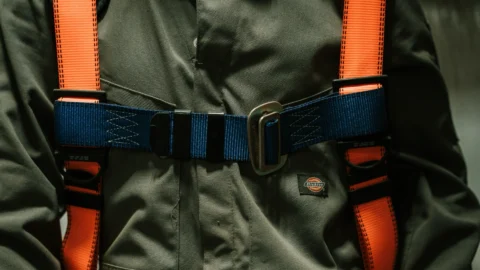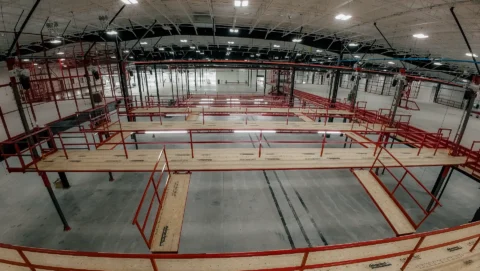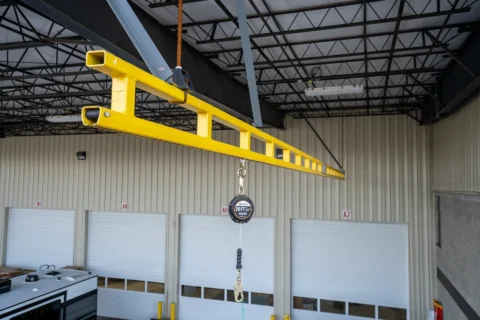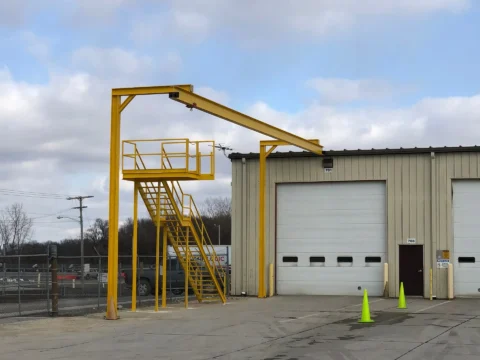One of our technicians was 20 feet above the shop floor, working on a crane rail, when he slipped. His fall arrest harness engaged—saving him from a dangerous fall. That split-second proved just how vital having the right fall protection at the right height really is.
Fall protection is one of those safety measures that nobody thinks they need, until the day they do. If you’re managing a manufacturing facility, you’re used to balancing compliance, productivity, and operational flow. But when it comes to fall hazards, there’s no room for shortcuts or second guesses.
So, at what height is fall protection actually required? Let’s break down the essentials, using real-world examples from my own experience helping manufacturers keep their teams safe.

What does fall protection really mean?
When we talk about fall protection, we’re not just talking about harnesses and lanyards (though those are key protections). Fall protection is any system or set of practices that either (a) prevents workers from falling from a certain height, or (b) protects them in case a fall does occur. This can mean:
- Personal fall arrest systems (harnesses, lanyards)
- Guardrails along walkways or platforms
- Safety nets
- Covers for holes or floor openings
- Clear, enforced safe work procedures
But the big idea? Minimize or eliminate the risk of injury and make sure everyone goes home safely at the end of the day.
Why fall protection matters
Falls are a top cause of injuries and fatalities in manufacturing and construction. If you’ve spent time in industrial environments—think steel fabrication, custom metalwork, or trailer production—you know walkways, platforms, and equipment maintenance all present fall hazards.
And even a short drop is enough to cause serious harm. Besides the obvious human cost, a single fall can trigger:
- Expensive workers’ comp claims
- Equipment repairs or investigations
- Disrupted operations or shutdowns
Preventable accidents impact your bottom line and can carry lifelong effects for those injured. Simply put: it’s never worth skipping safety.

Where is fall protection often forgotten?
Some tasks commonly missed include:
- Maintenance work on overhead cranes or up in the rafters
- Working atop machines and material handling equipment
- Loading/unloading from flatbeds or docks
- Accessing or cleaning rooftops and mezzanines
- Changing light fixtures or servicing HVAC units
People often skip harnesses or barriers because the job “only takes a minute.” That thinking is how incidents happen.
OSHA height requirements: What the rules actually say
Here’s the bottom line, straight from OSHA:
- General industry (most manufacturing environments): Fall protection must be provided at 4 feet or higher.
- Shipyards: 5 feet.
- Construction: 6 feet.
- Longshoring operations: 8 feet.
So, for most manufacturers, if someone’s working more than four feet off the ground—on a platform, a machine, a mezzanine—you need a fall protection system in place.
When it comes to scissor lifts or boom lifts: if the work platform is above 4 feet, you need a harness and secure tie-off. Even for quick moves or just driving the lift across the shop.
Special situations:
- Scaffolding requires fall protection at 10 feet.
- Steel erection: 15 feet or higher.
- Fixed ladders: Fall protection is required at 24 feet or more, usually with a cable safety system.
- Dangerous equipment: No minimum height—fall protection is needed any time you’re working over equipment that could injure you in a fall (think augers, conveyors, vats, etc.).

Are there any exceptions?
There are a few, but they’re narrow:
- Short-duration inspections: If you’re only up briefly for a pre- or post-work inspection (and not close to an edge or hazard), you might not need full protection.
- Infeasibility (greater hazard): If applying conventional fall protection would actually make the job more dangerous, you could have a case—but it requires documentation.
- Other industries, like agriculture or maritime, may have their own rules.
But these are the exception, not the norm. There is no “it’s just for a few minutes” loophole. OSHA focuses on risk, not how long the job takes.
What about tie-off points and system strength?
A safe fall protection system is only as strong as what it’s attached to. By standard, your tie-off point must support 5,000 pounds per attached worker. Yes, per person! This ensures that, even in a worst-case scenario (everyone tied off falling at the same time), the anchor holds.
- For permanent or complex systems, professional certification or regular inspection is a must. At PWI, we load test and inspect our own systems to keep everyone safe.
‘The six-foot rule’: Clearing up confusion
A lot of people get mixed up by the so-called “six-foot rule.” Here’s what’s true:
- Construction requires fall protection at 6 feet.
- General industry/manufacturing requires it at 4 feet.
If you’re ever unsure, follow the stricter rule. Better safe than sorry.
What about ladders?
Ladders are considered fall hazards, but standards are a bit different. You typically don’t need harnesses for portable ladders, but if it’s a fixed ladder above 24 feet, a cage or ladder safety system is required.
Real-life reminders: Why it matters every time
Let me share two quick stories to show why this isn’t just about compliance:
- Saved by the harness: One of our techs was 20 feet up, working on a crane rail, when he slipped. His harness stopped his fall and saved him from major injury. That incident made us extra vigilant—even routine jobs can catch you off guard.
- The close call: An HVAC contractor decided not to use fall protection for a “quick” repair. He fell, suffered serious injuries, and the facility completely overhauled their safety policy. Now, nobody works at height—vendor or employee—without the right gear.
No job is too small or too short for proper protection. The consequences of skipping it simply aren’t worth it.
Why do customers trust PWI?
PWI focuses on real safety, not just checking boxes. We design site-specific, custom solutions (not one-size-fits-all answers), stock essential equipment for fast turnaround, and offer tailored training. Most of the time, we get the call after a near miss or a scare—so we know how important it is to get people protected, fast.
We’re not just about following regulations. Our goal is to help you ensure everyone gets home safe, every single day.

Don’t forget the rescue plan
Wearing a harness is only part of the equation. If someone falls and is left hanging, they’re at serious risk of “suspension trauma” within 15–30 minutes. You need a rescue plan, so anyone who’s suspended can be rescued fast. Otherwise, you’re only halfway there on real-world safety.
In closing
If you’re managing a facility, don’t wait for a close call. Walk through your building, note every area above four feet—and make sure nobody is working there without proper protection and a solid rescue plan. Make fall safety a habit, not an afterthought. Call us or visit our website to start today!


